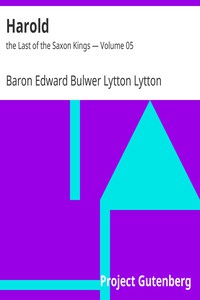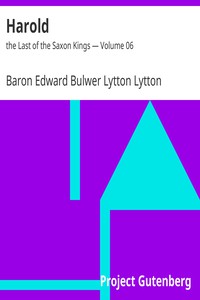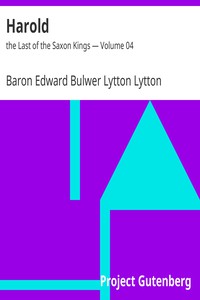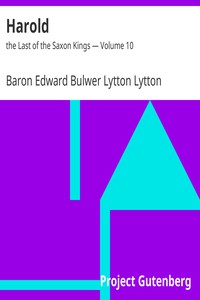Harold : the Last of the Saxon Kings — Complete by Lytton (an ebook reader TXT) 📖

- Author: Lytton
Book online «Harold : the Last of the Saxon Kings — Complete by Lytton (an ebook reader TXT) 📖». Author Lytton
215 (return)
See the judicious remarks of Henry, “Hist. of Britain,” on this head. From the lavish abuse of oaths, perjury had come to be reckoned one of the national vices of the Saxon.
216 (return)
And so, from Gryffyth, beheaded by his subjects, descended Charles Stuart.
217 (return)
Brompt. Chron.
218 (return)
See Note P.
219 (return)
It seems by the coronation service of Ethelred II. still extant, that two bishops officiated in the crowning of the King; and hence, perhaps, the discrepancy in the chronicles, some contending that Harold was crowned by Alred, others, by Stigand. It is noticeable, however, that it is the apologists of the Normans who assign that office to Stigand, who was in disgrace with the Pope, and deemed no lawful bishop. Thus in the Bayeux tapestry the label, “Stigand,” is significantly affixed to the officiating prelate, as if to convey insinuation that Harold was not lawfully crowned. Florence, by far the best authority, says distinctly, that Harold was crowned by Alred. The ceremonial of the coronation described in the text, is for the most part given on the authority of the “Cotton MS.” quoted by Sharon Turner, vol. iii. p. 151.
220 (return)
Introduced into our churches in the ninth century.
221 (return)
The Wyn-month: October.
222 (return)
“Snorro Sturleson.” Laing.
223 (return)
The Vaeringers, or Varangi, mostly Northmen; this redoubtable force, the Janissaries of the Byzantine empire, afforded brilliant field, both of fortune and war, to the discontented spirits, or outlawed heroes of the North. It was joined afterwards by many of the bravest and best born of the Saxon nobles, refusing to dwell under the yoke of the Norman. Scott, in “Count Robert of Paris,” which, if not one of his best romances, is yet full of truth and beauty, has described this renowned band with much poetical vigor and historical fidelity.
224 (return)
Laing’s Snorro Sturleson.—“The old Norwegian ell was less than the present ell; and Thorlasius reckons, in a note on this chapter, that Harold’s stature would be about four Danish ells; viz. about eight feet.”—Laing’s note to the text. Allowing for the exaggeration of the chronicler, it seems probable, at least, that Hardrada exceeded seven feet. Since (as Laing remarks in the same note), and as we shall see hereafter, “our English Harold offered him, according to both English and Danish authority, seven feet of land for a grave, or as much more as his stature, exceeding that of other men, might require.”
225 (return)
Snorro Sturleson. See Note Q.
226 (return)
Snorro Sturleson.
227 (return)
Hoveden.
228 (return)
Holinshed. Nearly all chroniclers (even, with scarce an exception, those most favouring the Normans), concur in the abilities and merits of Harold as a king.
229 (return)
“Vit. Harold. Chron. Ang. Norm.” ii, 243.
230 (return)
Hoveden.
231 (return)
Malmesbury.
232 (return)
Supposed to be our first port for shipbuilding.—FOSBROOKE, p. 320.
233 (return)
Pax.
234 (return)
Some of the Norman chroniclers state that Robert, Archbishop of Canterbury, who had been expelled from England at Godwin’s return, was Lanfranc’s companion in this mission; but more trustworthy authorities assure us that Robert had been dead some years before,
 Have you ever thought about what fiction is? Probably, such a question may seem surprising: and so everything is clear. Every person throughout his life has to repeatedly create the works he needs for specific purposes - statements, autobiographies, dictations - using not gypsum or clay, not musical notes, not paints, but just a word. At the same time, almost every person will be very surprised if he is told that he thereby created a work of fiction, which is very different from visual art, music and sculpture making. However, everyone understands that a student's essay or dictation is fundamentally different from novels, short stories, news that are created by professional writers. In the works of professionals there is the most important difference - excogitation. But, oddly enough, in a school literature course, you don’t realize the full power of fiction. So using our website in your free time discover fiction for yourself.
Have you ever thought about what fiction is? Probably, such a question may seem surprising: and so everything is clear. Every person throughout his life has to repeatedly create the works he needs for specific purposes - statements, autobiographies, dictations - using not gypsum or clay, not musical notes, not paints, but just a word. At the same time, almost every person will be very surprised if he is told that he thereby created a work of fiction, which is very different from visual art, music and sculpture making. However, everyone understands that a student's essay or dictation is fundamentally different from novels, short stories, news that are created by professional writers. In the works of professionals there is the most important difference - excogitation. But, oddly enough, in a school literature course, you don’t realize the full power of fiction. So using our website in your free time discover fiction for yourself. 




Comments (0)